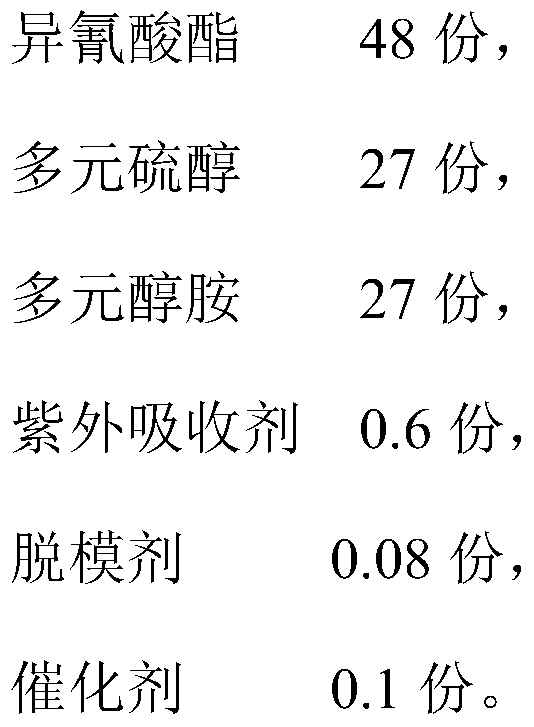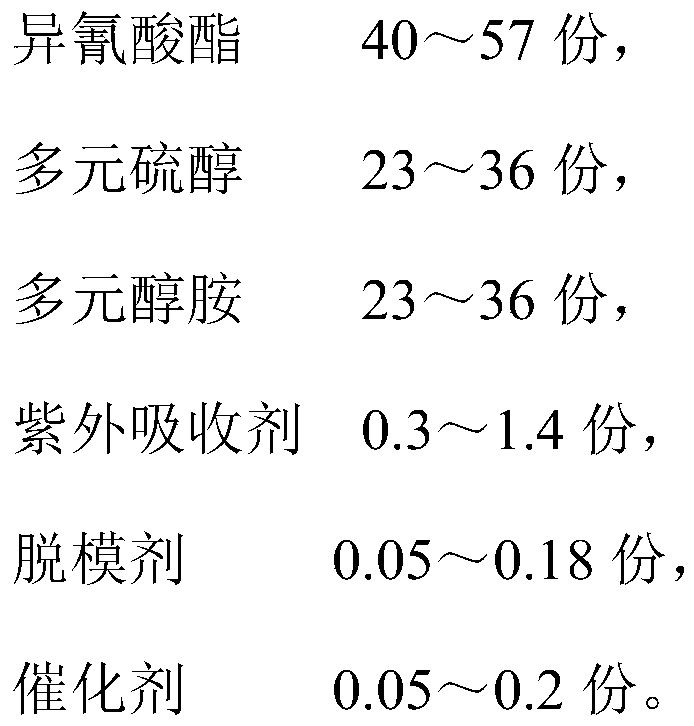Anti-impact super-tough lens material and preparation method thereof
An impact-resistant and super-tough technology, applied in the field of lenses, can solve the problems of reduced impact strength, reduced impact resistance of lenses, unsatisfactory adhesion between wear-resistant coatings and primers, etc., to achieve improved attachment Effects of poor grip, excellent abrasion resistance, and excellent UV resistance
- Summary
- Abstract
- Description
- Claims
- Application Information
AI Technical Summary
Problems solved by technology
Method used
Image
Examples
Embodiment 1
[0028] 1, the consumption of raw material is as follows in the present embodiment:
[0029] Isocyanates: 4,4-dicyclohexylmethane diisocyanate (20g), hexamethylene diisocyanate (28g);
[0030] Polymercaptans: pentaerythritol tetrakis(3-mercaptopropionate) (13.5g) and thiodiglycol (13.5g);
[0031] Polyolamine: bis(2-hydroxymethyl)amino-tris(hydroxymethyl)methane (27g);
[0032] UV absorber: 2-(2'-hydroxyl-5'-tert-octylphenyl)benzotriazole (0.6g);
[0033] Release agent: HILUB-67 (0.08g);
[0034] Catalyst: isopropyl titanate (0.1 g).
[0035] 2. Preparation method
[0036] S1. Weigh each component in proportion, mix and stir the isocyanate and catalyst, then add UV absorber and release agent in sequence, after vacuum defoaming at 25°C for 70 minutes, add polythiol and polyol amine, mix and stir Vacuum defoaming at 18°C for 35 minutes, then vacuum defoaming again for 15 minutes after stopping stirring, to obtain the resin lens composition ingredients;
[0037] S2. Dry ni...
Embodiment 2
[0039] 1, the consumption of raw material is as follows in the present embodiment:
[0040] Isocyanates: 4,4-dicyclohexylmethane diisocyanate (20g), hexamethylene diisocyanate (28g);
[0041] Polymercaptans: pentaerythritol tetrakis(3-mercaptopropionate) (13.5g) and thiodiglycol (13.5g);
[0042] Polyolamine: Bis(2-hydroxymethyl)amino-tris(hydroxymethyl)methane (27g);
[0043]UV absorber: 2-(2'-hydroxyl-5'-tert-octylphenyl)benzotriazole (0.6g);
[0044] Release agent: HILUB-67 (0.08g);
[0045] Catalyst: isopropyl titanate (0.1 g).
[0046] 2. Preparation method
[0047] S1. After mixing and stirring isocyanate and catalyst, add UV absorber and mold release agent in sequence, after vacuum degassing at 28°C for 50 minutes, add polythiol and polyol amine, mix, and vacuum defoam at 22°C for 30 minutes while stirring, After stopping the stirring, vacuum defoaming again for 10 minutes to obtain the resin lens composition ingredients;
[0048] S2. Dry nitrogen and pressurize, ...
Embodiment 3
[0050] 1, the consumption of raw material is as follows in the present embodiment:
[0051] Isocyanates: 4,4-dicyclohexylmethane diisocyanate (20g), hexamethylene diisocyanate (20g);
[0052] Polymercaptans: pentaerythritol tetrakis(3-mercaptopropionate) (27g) and thiodiethylene glycol (9g);
[0053] Polyolamine: Bis(2-hydroxymethyl)amino-tris(hydroxymethyl)methane (23g);
[0054] UV absorber: 2-(2'-hydroxyl-5'-tert-octylphenyl)benzotriazole (0.3g);
[0055] Release agent: HILUB-67 (0.18g);
[0056] Catalyst: isopropyl titanate (0.05 g).
[0057] 2. Preparation method
[0058] S1. Weigh each component in proportion, mix and stir the isocyanate and catalyst, then add UV absorber and mold release agent in turn, after vacuum defoaming at 25°C for 70 minutes, add polythiol and polyol amine, mix and stir Vacuum defoaming at 18°C for 35 minutes, then vacuum defoaming again for 15 minutes after stopping stirring, to obtain the resin lens composition ingredients;
[0059] S2. ...
PUM
| Property | Measurement | Unit |
|---|---|---|
| refractive index | aaaaa | aaaaa |
| transmittivity | aaaaa | aaaaa |
Abstract
Description
Claims
Application Information
 Login to View More
Login to View More - Generate Ideas
- Intellectual Property
- Life Sciences
- Materials
- Tech Scout
- Unparalleled Data Quality
- Higher Quality Content
- 60% Fewer Hallucinations
Browse by: Latest US Patents, China's latest patents, Technical Efficacy Thesaurus, Application Domain, Technology Topic, Popular Technical Reports.
© 2025 PatSnap. All rights reserved.Legal|Privacy policy|Modern Slavery Act Transparency Statement|Sitemap|About US| Contact US: help@patsnap.com



